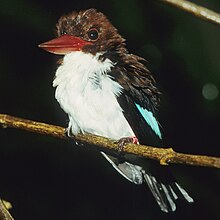
Kingfishers or Alcedinidae are a family of small to medium-sized, brightly colored birds in the order Coraciiformes. They have a cosmopolitan distribution, with most species found in the tropical regions of Africa, Asia, and Oceania. The family contains 114 species and is divided into three subfamilies and 19 genera. All kingfishers have large heads, long, sharp, pointed bills, short legs, and stubby tails. Most species have bright plumage with only small differences between the sexes. Most species are tropical in distribution, and a slight majority are found only in forests. They consume a wide range of prey usually caught by swooping down from a perch. While kingfishers are usually thought to live near rivers and eat fish, many species live away from water and eat small invertebrates. Like other members of their order, they nest in cavities, usually tunnels dug into the natural or artificial banks in the ground. Some kingfishers nest in arboreal termite nests. A few species, principally insular forms, are threatened with extinction. In Britain, the word "kingfisher" normally refers to the common kingfisher.

The common kingfisher, also known as the Eurasian kingfisher and river kingfisher, is a small kingfisher with seven subspecies recognized within its wide distribution across Eurasia and North Africa. It is resident in much of its range, but migrates from areas where rivers freeze in winter.

The woodland kingfisher is a tree kingfisher that is widely distributed in Africa south of the Sahara.

The blue-breasted kingfisher is a tree kingfisher widely distributed across Equatorial Africa. This kingfisher is essentially resident, but retreats from drier savanna areas to wetter habitats in the dry season.

The lilac-breasted roller is an African bird of the roller family, Coraciidae. It is widely distributed in sub-Saharan Africa, and is a vagrant to the southern Arabian Peninsula. It prefers open woodland and savanna, and it is for the most part absent from treeless places. Usually found alone or in pairs, it perches conspicuously at the tops of trees, poles or other high vantage points from where it can spot insects, lizards, scorpions, snails, small birds and rodents moving about on the ground. Nesting takes place in a natural hole in a tree where a clutch of 2–4 eggs are laid, and incubated by both parents, who are extremely aggressive in defence of their nest, taking on raptors and other birds. During the breeding season the male will rise to a fair height, descending in swoops and dives, while uttering harsh, discordant cries. The sexes are different in coloration, and juveniles lack the long tail streamers of adults. This species is officially considered the national bird of Kenya. Alternative names for the lilac-breasted roller include the fork-tailed roller, lilac-throated roller and Mosilikatze's roller.

The African pygmy kingfisher is a small insectivorous kingfisher found in the Afrotropics, mostly in woodland habitats.
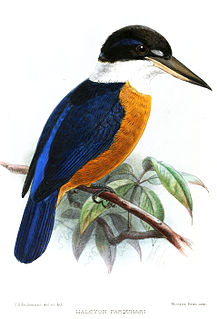
The Vanuatu kingfisher or chestnut-bellied kingfisher is a medium-sized kingfisher found only on the islands of Espiritu Santo, Malo and Malakula in Vanuatu.

Pelargopsis is a genus of tree kingfishers that are resident in tropical south Asia from India and Sri Lanka to Indonesia.

The Biak paradise kingfisher is a tree kingfisher that is endemic to the Indonesian island of Biak which is one of a small group of islands located in Cenderawasih Bay near the northern coast of Papua. This bird has a turquoise-blue back with a white belly and tail streamers and a reddish beak. Its natural habitat is forests and the IUCN has assessed its conservation status as being "near-threatened".

The yellow-billed kingfisher is a medium-sized tree kingfisher.
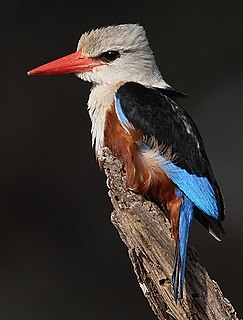
The grey-headed kingfisher has a wide distribution from the Cape Verde Islands off the north-west coast of Africa to Mauritania, Senegal and Gambia, east to Ethiopia, Somalia and southern Arabia and south to South Africa.
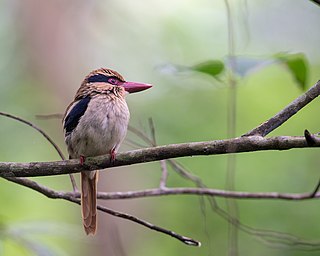
The lilac kingfisher or Celebes flat-billed kingfisher is a resident breeding bird in the lowlands of the Indonesia island of Sulawesi and the neighbouring Sangihe and Talaud Islands. It is the only member of the genus Cittura.

The moustached kingfisher, also called Bougainville moustached kingfisher, is a species of bird in the family Alcedinidae. It is endemic to Bougainville Island in Papua New Guinea. An estimated 250–1,000 mature individuals are left.
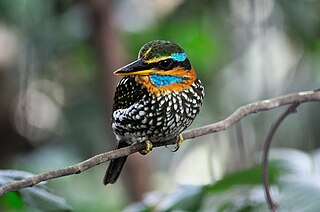
The spotted wood kingfisher or spotted kingfisher is a species of bird in the family Alcedinidae. It is endemic to the Philippines where its natural habitat is subtropical or tropical moist lowland forests.

The brown-hooded kingfisher is a species of bird in the subfamily Halcyoninae, the tree kingfishers. It has a brown head and blackish and turquoise wings. It is found in Sub-Saharan Africa, living in woodland, scrubland, forest edges, and also suburban areas. The International Union for Conservation of Nature (IUCN) has assessed it as being of least concern.
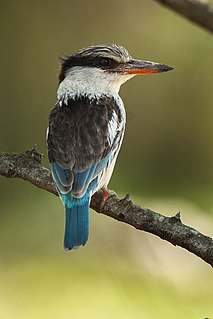
The striped kingfisher is a species of bird in the tree kingfisher subfamily. It was first described by Edward, Lord Stanley, in Salt's Voyage to Abyssinia in 1814 as "Chelicut kingfisher" Alaudo Chelicuti.
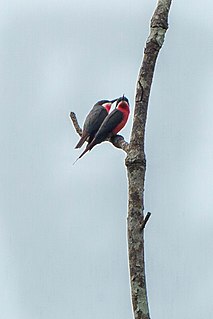
The rosy bee-eater is a species of bird in the family Meropidae. It is found in Angola, Benin, Burkina Faso, Republic of the Congo, Democratic Republic of the Congo, Ivory Coast, Equatorial Guinea, Gabon, Ghana, Nigeria, and Togo.

The red-backed kingfisher is a species of kingfisher in the subfamily Halcyoninae, also known as tree kingfishers. It is a predominantly blue-green and white bird with a chestnut rump. It is found across the continent of Australia, mainly inhabiting the drier regions.

Winchell's kingfisher or the rufous-lored kingfisher, is a species of bird in the family Alcedinidae, the kingfishers. It is endemic to the Philippines, its natural habitat being lowland forests. It is threatened by deforestation, and the International Union for Conservation of Nature (IUCN) has assessed it as a vulnerable species.

The tree kingfishers or wood kingfishers, subfamily Halcyoninae, are the most numerous of the three subfamilies of birds in the kingfisher family, with around 70 species divided into 12 genera, including several species of kookaburras. The subfamily appears to have arisen in Indochina and Maritime Southeast Asia and then spread to many areas around the world. Tree kingfishers are widespread through Asia and Australasia, but also appear in Africa and the islands of the Pacific and Indian Oceans, using a range of habitats from tropical rainforest to open woodlands.
